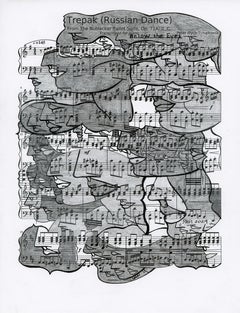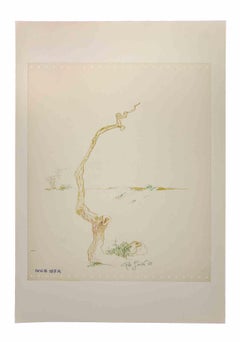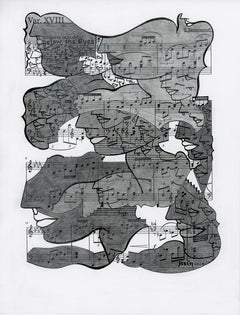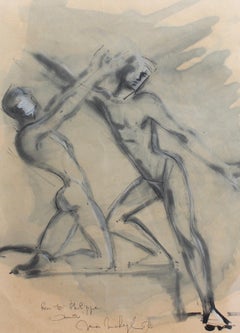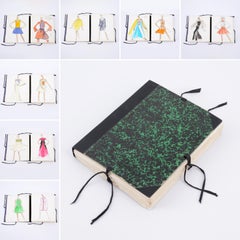Map Portrait Drawings and Watercolors
to
3
Overall Width
to
Overall Height
to
1
2
1
1
3
415
3,425
1,952
1,933
1,650
1,239
713
656
623
493
439
355
141
104
88
83
74
67
58
54
2
2
2
2
1
1
2
1
Art Subject: Map
Signed Feminist LGBTQ+ Ink Graphite on Paper Drawing - Profile Notation 418.010
Located in New York, NY
Linda Stein, Profile Notation 418.010 - Signed Feminist LGBTQ+ Ink and Graphite on Paper Drawing
Profile Notation 418.010 is from Linda Stein's Profiles series--drawings, collages ...
Category
2010s Feminist Figurative Drawings and Watercolors
Materials
Paper, Ink, Graphite
Eagle - Drawing by Leo Guida - 1970s
By Leo Guida
Located in Roma, IT
Eagle is an original Contemporary artwork realized in 1970 by the italian Contemporary artist Leo Guida (1992 - 2017).
Original drawing in china ink on ivory-colored paper, glued...
Category
1970s Contemporary Portrait Drawings and Watercolors
Materials
Pastel, Watercolor
Signed Feminist LGBTQ+ Ink Graphite on Paper Drawing - Profile Notation 418.012
Located in New York, NY
Linda Stein, Profile Notation 418.012 - Signed Feminist LGBTQ+ Ink and Graphite on Paper Drawing
Profile Notation 418.012 is from Linda Stein's Profiles series--drawings, collages ...
Category
2010s Feminist Figurative Drawings and Watercolors
Materials
Paper, Ink, Graphite
Related Items
Modern Dancers
By Mick Micheyl
Located in London, GB
'Modern Dancers', pastel, ink and gouache on fine art paper by French artist, singer and sculptor, Mick Micheyl (1964). Two elegant young men are depicted in a graceful dancing pose, arms outstretched, their lithe bodies so agile and limber. Perhaps one of the dancers was her friend, Philippe, to whom the painting is dedicated on the bottom. The dedication says: 'For you Philippe, all my friendship'. Signed: 'Mick Micheyl'. The work has been newly framed and glazed after having been acquired in the S. of France. It is in fair vintage condition commensurate with age showing minor blemishing on the paper. Upon request a video of the piece can be provided.
Dimensions with Frame:
H 75 cm / 29.5"
W 61 cm / 24"
Dimensions without Frame:
H 56 cm / 22"
W 42 cm / 16.5"
About the Artist: Mick Micheyl (1922 - 2019) was born in Lyon and had a busy and rewarding artistic career as a singer, producer, reviewer, metal sculptor, artist. After having received training at the School of Fine Arts in Lyon she became a painter and decorator in the theatre but then commenced a career in the musical activities of a theatrical troupe. She won the ABC competition in Paris in 1949 with a song, Le Marchand de Poésie, which she composed herself. She then performed in many cabarets: L'Échelle de Jacob, Harlequin and Liberty's. In the 1950s she was one of the most important French cabaret singers of that period. One of her titles, 'Un Gamin de Paris', became one of the French standards and also performed by Yves Montand and Robert Clary...
Category
1960s Modern Portrait Drawings and Watercolors
Materials
Paper, Pastel, Ink, Gouache
Karl Lagerfeld Fashion Portfolio / Drawings for Tiziani, 161 Drawings
Located in Lake Worth Beach, FL
Artist/Designer: Karl Lagerfeld (1933-2019)
Marking(s); notes: marking(s)
Materials: paper
Dimensions: approx. 12.75"h, 10"w (159 images)
Additional Information: Fashion design sketc...
Category
1960s Feminist Figurative Drawings and Watercolors
Materials
Paper
H 12.75 in W 10 in D 0.1 in
Chez Maxim's
By André Meurice
Located in London, GB
'Chez Maxim's', pastel and gouache on fine art paper, by André Meurice (circa 1950s - 60s). The artist depicts the glamorous clientele at the entryway to...
Category
Mid-20th Century Art Nouveau Figurative Drawings and Watercolors
Materials
Pastel, Gouache
Portrait of Young African American Man in Yellow Rain Jacket
Located in Fredericksburg, VA
This vivid pastel portrait features a young African American man wearing a bright yellow rain jacket. The artist’s use of pastel captures the jacket's luminous color with striking in...
Category
21st Century and Contemporary Contemporary Portrait Drawings and Waterco...
Materials
Paper, Pastel
Rare Modernist Hungarian Rabbi Pastel Drawing Gouache Painting Judaica Art Deco
Located in Surfside, FL
Rabbi in the synagogue at prayer wearing tallit and tefillin.
Hugó Scheiber (born 29 September 1873 in Budapest – died there 7 March 1950) was a Hungarian modernist painter.
Hugo Scheiber was brought from Budapest to Vienna at the age of eight where his father worked as a sign painter for the Prater Theater. At fifteen, he returned with his family to Budapest and began working during the day to help support them and attending painting classes at the School of Design in the evening, where Henrik Papp was one of his teachers. He completed his studies in 1900. His work was at first in a post-Impressionistic style but from 1910 onward showed his increasing interest in German Expressionism and Futurism. This made it of little interest to the conservative Hungarian art establishment.
However, in 1915 he met the great Italian avant-gardist Filippo Tommaso Marinetti and the two painters became close friends. Marinetti invited him to join the Futurist Movement. The uniquely modernist style that he developed was, however, closer to German Expressionism than to Futurism and eventually drifted toward an international art deco manner similar to Erté's. In 1919, he and his friend Béla Kádar held an exhibition at the Hevesy Salon in Vienna. It was a great success and at last caused the Budapest Art Museum to acquire some of Scheiber's drawings. Encouraged, Scheiber came back to live in Vienna in 1920.
A turning point in Scheiber's career came a year later, when Herwarth Walden, founder of Germany's leading avant-garde periodical, Der Sturm, and of the Sturm Gallery in Berlin, became interested in Scheiber's work. Scheiber moved to Berlin in 1922, and his paintings soon appeared regularly in Walden's magazine and elsewhere. Exhibitions of his work followed in London, Rome, La Paz, and New York.
Scheiber's move to Germany coincided with a significant exodus of Hungarian artists to Berlin, including Laszlo Moholy-Nagy and Sandor Bortnyik. There had been a major split in ideology among the Hungarian avant-garde. The Constructivist and leader of the Hungarian avantgarde, Lajos Kassák (painted by Hugó Scheiber in 1930) believed that art should relate to all the needs of contemporary humankind. Thus he refused to compromise the purity of his style to reflect the demands of either the ruling class or socialists and communists. The other camp believed that an artist should be a figurehead for social and political change.
The fall out and factions that resulted from this politicisation resulted in most of the Hungarian avant gardists leaving Vienna for Berlin. Hungarian émigrés made up one of the largest minority groups in the German capital and the influx of their painters had a significant effect on Hungarian and international art. Another turning point of Scheiber's career came in 1926, with the New York exhibition of the Société Anonyme, organized by Katherine Dreier. Scheiber and other important avant garde artists from more than twenty-three countries were represented. In 1933, Scheiber was invited by Marinetti to participate in the great meeting of the Futurists held in Rome in late April 1933, Mostra Nazionale d’Arte Futurista where he was received with great enthusiasm. Gradually, the Hungarian artists began to return home, particularly with the rise of Nazism in Germany. Kádar went back from Berlin in about 1932 and Scheiber followed in 1934.
He was then at the peak of his powers and had a special flair in depicting café and cabaret life in vivid colors, sturdily abstracted forms and spontaneous brush strokes. Scheiber depicted cosmopolitan modern life using stylized shapes and expressive colors. His preferred subjects were cabaret and street scenes, jazz musicians, flappers, and a series of self-portraits (usually with a cigar). his principal media being gouache and oil. He was a member of the prestigious New Society of Artists (KUT—Képzőművészek Új Társasága)and seems to have weathered Hungary's post–World War II transition to state-communism without difficulty. He continued to be well regarded, eventually even receiving the posthumous honor of having one of his images used for a Russian Soviet postage stamp (see image above). Hugó Scheiber died in Budapest in 1950.
Paintings by Hugó Scheiber form part of permanent museum collections in Budapest (Hungarian National Museum), Pecs (Jannus Pannonius Museum), Vienna, New York, Bern and elsewhere. His work has also been shown in many important exhibitions, including:
"The Nell Walden Collection," Kunsthaus Zürich (1945)
"Collection of the Société Anonyme," Yale University Art Gallery, New Haven, Connecticut (1950)
"Hugó Scheiber: A Commemorative Exhibition," Hungarian National Museum, Budapest (1964)
"Ungarische Avantgarde," Galleria del Levante, Munich (1971)
"Paris-Berlin 1900-1930," Centre Georges Pompidou, Paris (1978)
"L’Art en Hongrie, 1905-1920," Musée d’Art et l’Industrie, Saint-Etienne (1980)
"Ungarische Avantgarde in der Weimarer Republik," Marburg (1986)
"Modernizmus," Eresz & Maklary Gallery, Budapest (2006)
"Hugó Scheiber & Béla Kádár," Galerie le Minotaure, Paris and Tel Aviv (2007)
Hugó Scheiber's paintings continue to be regularly sold at Sotheby's, Christie's, Gillen's Arts (London), Papillon Gallery (Los Angeles) and other auction houses.
He was included in the exhibition The Art Of Modern Hungary 1931 and other exhibitions along with Vilmos Novak Aba, Count Julius Batthyany, Pal Bor, Bela Buky, Denes Csanky, Istvan Csok, Bela Czobel, Peter Di Gabor, Bela Ivanyi Grunwald, Baron Ferenc Hatvany, Lipot Herman, Odon Marffy, C. Pal Molnar...
Category
Early 20th Century Modern Figurative Paintings
Materials
Paper, Charcoal, Pastel, Watercolor, Gouache
"A Martinique Native in French Guyana, " Black Female Portrait, Female Artist
Located in New York, NY
May Mott Smith (1879 - 1952)
A Martinique Native in French Guiana, circa 1925
Watercolor on paper
24 x 20 inches
Signed lower right; titled on the reverse
“Martinique Native” is an ...
Category
1920s Feminist Portrait Drawings and Watercolors
Materials
Paper, Watercolor
Tippie Comic Strip Original Art - Female Cartoonist
Located in Miami, FL
An early example from pioneering Female Cartoonist/ Illustrator Edwina Dumm, who draws a comic strip from her long-running cartoon series Tippie which lasted for almost five decades. Signed and dated Edwina, 9-25, matted but unframed.
Frances Edwina Dumm (1893 – April 28, 1990) was a writer-artist who drew the comic strip Cap Stubbs and Tippie for nearly five decades; she is also notable as America's first full-time female editorial cartoonist. She used her middle name for the signature on her comic strip, signed simply Edwina.
Biography
One of the earliest female syndicated cartoonists, Dumm was born in Upper Sandusky, Ohio, and lived in Marion and Washington Courthouse, Ohio throughout her youth before the family settled down in Columbus.[1] Her mother was Anna Gilmore Dennis, and her father, Frank Edwin Dumm, was an actor-playwright turned newspaperman. Dumm's paternal grandfather, Robert D. Dumm, owned a newspaper in Upper Sandusky which Frank Dumm later inherited. Her brother, Robert Dennis Dumm, was a reporter for the Columbus Dispatch, and art editor for Cole Publishing Company's Farm & Fireside magazine.
In 1911, she graduated from Central High School in Columbus, Ohio, and then took the Cleveland-based Landon School of Illustration and Cartooning correspondence course. Her name was later featured in Landon's advertisements. While enrolled in the correspondence course, she also took a business course and worked as a stenographer at the Columbus Board of Education.
In 1915, Dumm was hired by the short-lived Republican newspaper, the Columbus Monitor, to be a full-time cartoonist.[2] Her first cartoon was published on August 7, 1915, in the debut issue of the paper. During her years at the Monitor she provided a variety of features including a comic strip called The Meanderings of Minnie about a young tomboy girl and her dog, Lillie Jane, and a full-page editorial cartoon feature, Spot-Light Sketches[3]. She drew editorial cartoons for the Monitor from its first edition (August 7, 1915) until the paper folded (July 1917). In the Monitor, her Spot-Light Sketches was a full-page feature of editorial cartoons, and some of these promoted women's issues. Elisabeth Israels Perry, in the introduction to Alice Sheppard's Cartooning for Suffrage (1994), wrote that artists such as Blanche Ames Ames, Lou Rogers and Edwina Dumm produced:
...a visual rhetoric that helped create a climate more favorable to change in America's gender relations... By the close of the suffrage campaign, women's art reflected the new values of feminism, broadened its targets, and attempted to restate the significance of the movement.[4]
After the Monitor folded, Dumm moved to New York City, where she continued her art studies at the Art Students League. She was hired by the George Matthew Adams Service[5] to create Cap Stubbs and Tippie, a family strip following the lives of a boy Cap, his dog Tippie, their family, and neighbors. Cap's grandmother, Sara Bailey, is prominently featured, and may have been based on Dumm's own grandmother, Sarah Jane Henderson, who lived with their family. The strip was strongly influenced by Mark Twain’s Adventures of Huckleberry Finn, as well as Dumm’s favorite comic, Buster Brown by Richard F. Outcault. Dumm worked very fast; according to comics historian Martin Sheridan, she could pencil a daily strip in an hour.[6]
Her love of dogs is evident in her strips as well as her illustrations for books and magazines, such as Sinbad, her weekly dog page which ran in both Life and the London Tatler. She illustrated Alexander Woollcott's Two Gentlemen and a Lady. For Sonnets from the Pekinese and Other Doggerel (Macmillan, 1936) by Burges Johnson (1877–1963), she illustrated "Losted" and other poems.
From the 1931 through the 1960s, she drew another dog for the newspaper feature Alec the Great, in which she illustrated verses written by her brother, Robert Dennis Dumm. Their collaboration was published as a book in 1946. In the late 1940s, she drew the covers for sheet music by her friend and neighbor, Helen Thomas, who did both music and lyrics. During the 1940s, she also contributed Tippie features to various comic books including All-American Comics and Dell Comics.
In 1950, Dumm, Hilda Terry, and Barbara Shermund...
Category
1920s Conceptual Figurative Drawings and Watercolors
Materials
Ink, Color Pencil, Graphite
Jaider Portrait. Watercolor, Ink and Pastel on Archival Paper.
Located in Miami Beach, FL
Jaider by Celso Castro-Daza
One of a kind
Watercolor, ink, and paster on an archival paper
Sheet Size: 19.50 H x 13.75 W
2018
Unframed
Drawing on paper is his basic work tool, s...
Category
2010s Contemporary Portrait Drawings and Watercolors
Materials
Watercolor, Archival Paper, Pastel, Archival Ink
H 19.5 in W 13.75 in D 0.1 in
The unseen. Drawing, pastel, ink and colored pencils
Located in Bogotá, Bogotá
Pastel, Pencil, petal flowers, Color and Ink on Paper.
The base of this drawing is Fabriano paper of 120g /m2. I use natural dyes of flowers, herbs, leaves, bark of trees as the fir...
Category
2010s Contemporary Portrait Drawings and Watercolors
Materials
Paper, Pastel, Ink, Pencil, Color Pencil
18th century pastel portrait of Lady Augusta Corbett and her son, Stuart
Located in London, GB
Collections:
Commissioned by Andrew Corbett, husband of the sitter;
The Venerable Stuart Corbett;
Sir Stuart Corbett;
By descent to 2002;
Sotheby’s, London 21 March 2002, lot.104;
Lowell Libson...
Category
18th Century Old Masters Portrait Drawings and Watercolors
Materials
Pastel, Gouache
Portrait - Ink on Paper Unique Signed Drawing Surrealist Woman Painter, c. 1960
By Leonor Fini
Located in New York, NY
Leonor Fini
Portrait, ca. 1960
Ink on paper
14.5 x 10 cm 5 1/2 x 4 in.
37.5 x 33 cm 14 1/2 x 13 in. (Frame included)
Unique work
Exhibition history: Leonor Fini: Small Faces, Apri...
Category
1960s Surrealist Figurative Drawings and Watercolors
Materials
Paper, Ink, Graphite
"Jade", Figurative, Portrait, Acrylic, Chalk Pastel, Wax Pastel
By Chambers Austelle
Located in Philadelphia, PA
This figurative portrait drawing titled "Jade" is an original artwork by Chambers Austelle made of acrylic, chalk pastel, wax pastel. This piece measures 12"h x 12"w.
Chambers Austelle is a contemporary figurative painter and educator living and working in Charleston, SC. Austelle is best known for her compositions of vivid color and female subjects. The isolated environments challenge the viewer to question the way beauty and women are perceived in our culture.
Austelle’s work has been exhibited nationally and exists in many private collections. She was awarded Best in Show at The City Gallery for “Piccolo Spoleto’s 2016 Juried Exhibition”, as well as Charlie Magazine’s “50 Most Progressive”. Most recently, she was the 2018 recipient of St. Thomas’ Artist...
Category
21st Century and Contemporary Contemporary Portrait Drawings and Waterco...
Materials
Chalk, Oil Pastel, Pastel, Acrylic
